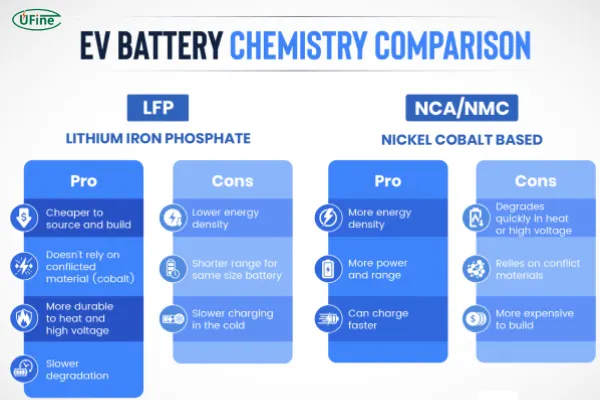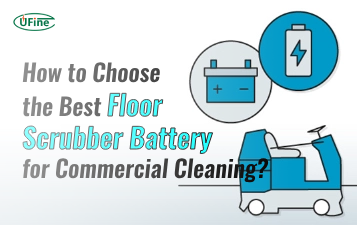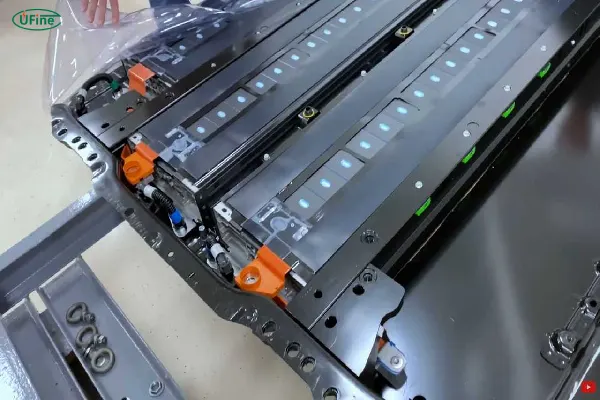Part 1. Tesla battery cell types
Tesla’s battery cells come in a variety of formats, but the most notable in recent years are the cylindrical 2170 and 4680 cells. The 2170 cell, used in Model 3 and Model Y, is a 21mm diameter and 70mm length cylindrical cell, while the 4680 cell, recently introduced for future models, is a larger 46mm diameter and 80mm length cylindrical cell. Both these formats are designed to maximize energy density and reduce the overall cost per kilowatt-hour (kWh).
The transition to LFP (Lithium Iron Phosphate) batteries in Tesla’s entry-level vehicles is a significant shift, as these batteries come with different characteristics, particularly in terms of cost-effectiveness, safety, and longevity.
Part 2. Tesla battery cell chemical composition

Tesla’s standard lithium-ion batteries have typically used Nickel Cobalt Aluminum (NCA) chemistry for the high-energy models (longer-range variants), while LFP (Lithium Iron Phosphate) batteries, which Tesla is now increasingly adopting, use iron phosphate for the cathode material. This composition brings about several unique advantages:
- Higher thermal stability compared to NCA or NCM (Nickel Cobalt Manganese) batteries.
- Greater safety profile: LFP batteries are less likely to catch fire or overheat, making them more stable.
- Lower cost: LFP chemistry is abundant and less expensive to produce, primarily because iron and phosphate are cheaper and more abundant materials than cobalt and nickel.
However, LFP batteries typically have lower energy density, which results in a slightly lower range per charge when compared to NCA-based cells, especially for high-performance models.
Part 3. Pros and cons of Tesla’s LFP batteries
Tesla’s move towards LFP batteries, especially for its Model 3 Standard Range vehicles, has both distinct benefits and challenges. Let’s take a deeper look:
Advantages of LFP Batteries:
- Cost-Effective: LFP batteries are cheaper to manufacture, which can lead to more affordable electric vehicles (EVs).
- Longer Lifespan: LFP cells are known for their longer cycle life. They can withstand more charge-discharge cycles before degradation compared to traditional NCA/NCM batteries.
- Better Safety: LFP batteries are far less prone to thermal runaway and overheating, making them inherently safer.
- Environmental Benefits: LFP batteries contain no cobalt or nickel, reducing the environmental impact of mining these materials.
Disadvantages of LFP Batteries:
- Lower Energy Density: Compared to NCA/NCM batteries, LFP batteries offer lower energy density, which means slightly shorter ranges for vehicles using this technology.
- Cold-Weather Performance: LFP batteries tend to have reduced efficiency in cold climates, although Tesla has addressed this issue with advanced thermal management systems.
- Slow Charging Speed: LFP batteries tend to charge slower compared to NCA-based cells, although Tesla is making strides in improving charging times.
Part 4. Current use of LFP batteries in Tesla
As of 2021, Tesla began equipping its Model 3 Standard Range Plus (SR+) vehicles with LFP batteries. These vehicles are primarily sold in China and Europe, where demand for more affordable electric vehicles is strong.
In the United States, LFP batteries are expected to become more common as Tesla expands its EV lineup and as battery prices continue to fall.
Interestingly, Tesla’s Gigafactory in Shanghai has been producing LFP batteries under a partnership with CATL (Contemporary Amperex Technology Co. Limited), one of the largest LFP battery manufacturers globally. This partnership has helped Tesla maintain competitive pricing and supply chain flexibility.
Part 5. Which Carmakers Are Adopting LFP Batteries?
Tesla is not alone in its shift toward LFP technology. Other leading electric vehicle manufacturers are also exploring or already adopting LFP batteries in their fleets:
- BYD: One of the largest manufacturers of electric vehicles in China, BYD has adopted LFP batteries in several of its vehicles, including the Tang EV and Qin Plus EV.
- Volkswagen: The German automaker is set to adopt LFP chemistry for certain budget models in its ID series.
- Ford: Ford has announced plans to incorporate LFP batteries in some of its Mustang Mach-E models in the future.
- General Motors: GM is also eyeing LFP for future EV models, particularly in the Chinese market, where cost-efficiency is a key factor.
The widespread adoption of LFP batteries could reduce the global reliance on cobalt and nickel, aligning with sustainability goals for the EV industry.
Part 6. Tesla’s battery future trends
Tesla’s focus on LFP batteries aligns with its long-term strategy of reducing costs while increasing vehicle production. As battery supply chains stabilize and improve, Tesla’s move to mass produce more affordable EVs will heavily rely on the advantages of LFP batteries, especially as LFP chemistry improves in terms of energy density.
Tesla is also working on optimizing its 4680 cell technology, which might integrate LFP chemistry into this new cell format to achieve even greater cost savings, energy efficiency, and longer vehicle range.
Part 7. Should I buy a Tesla with LFP batteries?
If you’re considering purchasing a Tesla with LFP battery technology, there are several key factors to weigh:
- If you are looking for a more affordable electric vehicle, especially for daily commutes, the Model 3 with LFP battery could be an excellent choice, as it provides lower upfront costs without compromising too much on range or performance.
- For cold-weather regions, LFP batteries may present a challenge due to their reduced performance in extreme temperatures, though Tesla has incorporated technologies to manage this issue.
- For long-range requirements, models with NCA chemistry might still be preferable if you need maximum driving distance between charges.
Part 8. Final words
Ultimately, Tesla’s LFP battery offers a more cost-efficient alternative, making it ideal for users looking for affordable, durable, and safe EV options.
With these insights, you can evaluate whether a Tesla LFP battery suits your needs, taking into account cost, safety, and performance factors. Whether you’re interested in battery longevity, environmental benefits, or future trends in electric vehicles, Tesla’s strategic use of LFP batteries is reshaping the EV market for the better.
For custom-made solutions tailored to your specific needs, contact Ufine Battery today, and let us help you with high-quality battery systems designed for performance and efficiency.
Part 9. FAQs
-
Can I upgrade my Tesla to an LFP battery?
No, upgrading a Tesla to an LFP battery is not possible unless you purchase a new vehicle that comes equipped with this battery type. -
How long will the LFP battery in my Tesla last?
LFP batteries typically have a lifespan of 3000-5000 cycles, which translates to 8-10 years depending on driving habits and environmental conditions. -
Is the LFP battery in Tesla vehicles slower to charge than other battery types?
Yes, LFP batteries generally have a slower charging rate compared to NCA cells, but Tesla’s optimization efforts are minimizing these differences. -
What is the environmental impact of LFP batteries?
LFP batteries are environmentally friendlier than those with cobalt and nickel, as they avoid the mining of these metals, reducing environmental harm. -
Can I expect the same driving range with a Tesla LFP battery as with a nickel-based battery?
Tesla’s LFP-equipped vehicles may have a slightly shorter range per charge, but advancements in battery management systems are closing this gap.
Related Tags:
More Articles

How to Choose the Best Floor Scrubber Battery for Commercial Cleaning?
Selecting the ideal floor scrubber battery ensures a long runtime, rapid charging, and minimal maintenance for efficient commercial cleaning operations.
Battery for Blower vs Battery for Leaf Vacuum: Which One Should You Choose?
Battery for blower vs leaf vacuum—learn the key differences in power, fit, and runtime to choose the right battery for your outdoor tool needs.
How to Choose the Right Battery for Blower?
Choosing the right blower battery? Consider voltage, capacity, chemistry & usage. This guide helps match the best battery for peak performance.
How to Choose the Best Insulated Battery Box for Lithium Batteries?
Choosing the Best Insulated Battery Box for Lithium Batteries? Discover key factors such as size, material, and safety for optimal protection and performance.
7 Critical Elements on a Lithium Battery Shipping Label
What must be on a lithium battery shipping label? Learn 7 key elements to ensure safety, legal compliance, and correct handling across all transport modes.




